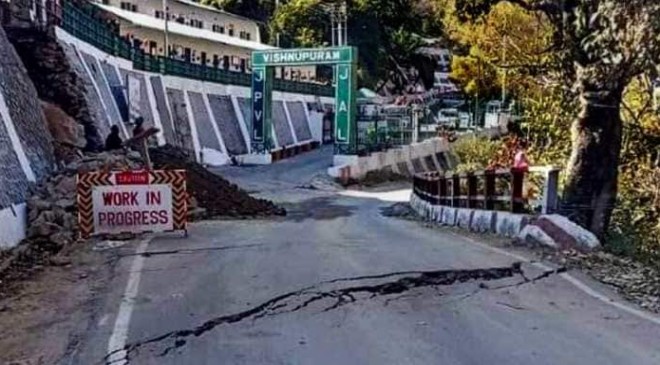An important spiritual and cultural destination of India, the Uttarakhand town of Joshimath is in a state of panic. After huge cracks developed in several houses, thanks to land subsidence, the town – already located in a sensitive zone – face threat. Here’s looking at the latest development and finding out why the town is sinking.
Uttarakhand Chief Minister Pushkar Singh Dhami is all set to visit the “sinking” town of Joshimath on Saturday (January 7). A place of religious and cultural importance, land subsidence has caused cracks in at least 500 homes in the Uttrakhand town, threatening to bring them down. A temple collapsed on Friday evening in Singdhar ward of Joshimath further alarming residents living under constant fear of a major disaster in the offing. Several experts have warned that many houses in the town are unlikely to survive.
A look at Joshimath: Development so far – 10 points
Ahead of Dhami’s visit, here’s looking at 10 key developments in Joshimath:
1) A spiritual town in Uttarakhand where Adi Shankaracharya, a religious reformer, acquired enlightenment in the eighth century, Joshimath has become a hot topic of discussion in the country, and for a rather scary reason. Several houses in the region have developed huge cracks and with the town situated on a fragile mountain slope, panic has gripped the population that it will totally sink.
2) On Friday (January 6), CM Pushkar Singh Dhami ordered an immediate evacuation of around 600 families living in houses with huge cracks. “Saving lives is our first priority. Officials have been asked to shift around 600 families living in endangered houses in Joshimath to safe locations,” Dhami told reporters after reviewing the situation in the sinking town with officials via video conference.
3) While the situation was already tense, a temple collapsed on Friday evening in Singdhar ward of Joshimath further added the alam of residents who have been living under constant fear of a major disaster in the offing. Luckily there was no one inside the temple when it collapsed as it had been abandoned after it developed huge cracks over the past 15 days, locals said.
4) Land subsidence has been going on for more than a year but the problem has aggravated over the past fortnight, authorities say.
Read more: Post Office PPF Scheme: Invest Rs 417, get Rs 1 crore at maturity
5) Marwari area where an aquifer burst three days ago is the worst hit. Several houses there were damaged in varying degrees while water from the aquifer is constantly flowing down with great force.
Cracks appear in the houses due to landslides at Joshimath of Chamoli district of Uttarakhand (Pic: PTI)
6) All construction activities related to mega projects like the Chardham all-weather road (Helang- Marwari bypass) and the NTPC’s hydel project have been stopped till further orders on the demand of residents.
7) The Auli ropeway service has also been stopped after a huge crack developed beneath it, former president of the local municipality Rishi Prasad Sati said. A huge crack developed beneath the Auli ropeway, which is Asia’s biggest. All construction activities related to mega projects like the Chardham all-weather road and the NTPC’s hydel project have been stopped till further orders on the demand of residents.
8) Chief Minister Dhami has said that for permanent rehabilitation of affected people, alternative locations should be identified in Pipalkoti, Gauchar and other places.
9) The state government has dispatched a team of experts to the area to assess the situation. Teams from NDRF have also been deployed in the area as a precautionary measure, Chamoli Chief Development Officer (CDO) Lalit Narayan Mishra said on Friday (january 6). “We have to be alert for the future, so NDRF is being deployed as a precautionary measure,” he said. “Due to frequent landslides, NDRF has been called and the team of experts is surveying the affected areas since this morning,” he added.
10) Panic has gripped the town. Terrified, many people have left their homes. At the same time, people are being shifted to municipal buildings, gurudwaras and schools by the administration.
A team of experts and scientists inspect cracks that developed in a road due to land subsidence in Joshimath (Pic: IANS)
Why is Joshimath sinking – check what experts say
A variety of factors, both anthropogenic and natural, have led to the subsidence of Joshimath, experts say. Talking to PTI, director of the Wadia Institute of Himalayan Geology Kalachand Sain listed out three principal factors behind the current crisis:
1) Joshimath’s vulnerable foundations: The town was developed on the debris of a landslide triggered by an earthquake more than a century ago.
2) Its location is in seismic zone V which is more prone to earthquakes.
3) Gradual weathering and water percolation which is reducing the cohesive strength of the rocks over time.
Indiscriminate construction has also resulted in disaster. As Sain pointed out, “Joshimath is the gateway to Badrinath, Hemkund Sahib and skiing destination Auli. Haphazard construction activities have been going on in the area for a long time without thinking about the pressure the town is capable of coping with…Hotels and restaurants have mushroomed everywhere. The pressure of population and the size of the crowd of tourists has also increased manifold.”
The going down of the Himalayan rivers and heavy rainfall which is characteristic of the area beside the flashfloods in Rishiganga and Dhauliganga rivers last year may also have worsened the situation, Sain added





































